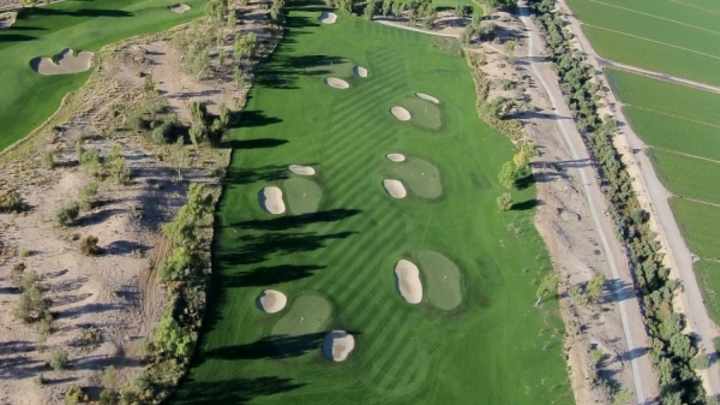Golf course designers have gotten creative during pandemic

In a year drenched in COVID-19 negatives, one of the sun-splashed positives is the dramatic jump in golf rounds played compared with 2019. According to the National Golf Foundation, citing Golf Datatech findings, November marked the sixth consecutive month that play has been up year-over-year in each of the lower 48 states. The research revealed that rounds are up nearly 13 percent for the year, despite losing 20 million rounds in the spring, when courses were closed due to Coronavirus restrictions.
Rounds for every playing category have soared, notably among women, juniors and beginners. The industry has also witnessed an increase of players walking courses and a rise of golfers frequenting nine-hole courses.
All of these pandemic golf traits have not gone unnoticed by architects. In many instances, they have seized on the trends that had started prior to this period, and further emphasized them. In other cases, they’ve responded directly to the challenges posed by new golfers and changed conditions. It all adds up to a more inclusive, accessible, fun form of golf for players of all levels.
During a year-end virtual meeting among the leaders of the American Society of Golf Course Architects (ASGCA), the European Institute of Golf Course Architects (EIGCA) and the Society of Australian Golf Course Architects (SAGCA), there was plenty of discussion about how golf has changed during the pandemic and further elaboration on how architects were adapting to these changes.
For Forrest Richardson, president of the ASGCA, this period has continued a recent trend to think smaller.

“Playing the game does not have to rely on taking up hundreds of acres, where every course has to be 7,000 yards and par 72,” he said. “Many of my clients are asking for downsizing. Whether it’s turning a par 72 into a par 70 or 68, or cutting 27 holes to 18 or building a par-3 course, we’re planning smaller footprints.”
SAGCA President Harley Kruse, who spent 10 years with Greg Norman Golf Course Design before venturing on his own in 2010, remarked that all the new golfers entering the game during the pandemic period has caused designers to reevaluate existing courses and to get creative about future projects.
“Clubs are attempting to figure out how to be relevant to the eight-year-old and the 88-year old,” he said. “The opportunity for us as designers is to have short game areas, perhaps even short holes, within a facility.”
Kruse noted that he has a project where he’s installing six short holes onto a club’s driving range.
“So you can turn the practice range off,” he said, “and all of a sudden, there are six holes the kids can play or maybe some of the octogenarians can go play on a Thursday morning before they have lunch with their mates because the big 18-hole course is now too much for them.”
Brian Curley and Fred Couples successfully fused short holes onto the practice range with #miniDunes at Arizona’s Ak-Chin Southern Dunes Golf Club in 2014 and earlier, David McLay Kidd did the same with the nine-hole Shorty’s at Oregon’s Bandon Dunes. Worldwide, it would be a welcome trend.
Kruse also observed that sustainability and playability can and should go together.

“Every club is looking at operations costs,” he said. “Reducing the number of bunkers would help on maintenance costs and would also help golfers play more quickly. As (architect and former pro) Michael Clayton told me, ‘Augusta National only has 44 bunkers. There were only 22 at the beginning. If 22 bunkers were enough for Bobby Jones and Alister MacKenzie that should be good enough for us.’”
Origins Golf Design architect Todd Eckenrode’s clientele is composed of many Golden Age private clubs in California, but they too have changing dynamics in the pandemic.
“We were already addressing playability and pace of play issues,” said Eckenrode, “but with all of the new players and increased play, it has raised awareness. An emphasis on enjoyment has led us to build additional forward tees, open up more green fronts by shifting or removing bunkers and by eliminating heavy rough around the greens in favor of short-cut areas, where you can use a variety of clubs.”
Perhaps Richardson is right in that pandemic golf has brought us closer to the soul of the game.
“Single rider carts and more walking will — hopefully — rid us of the massive systems of cart paths that have to be integrated into all projects,” he said. “With lighter-weight modes of getting one golfer and a single set of clubs around a course — now perfectly acceptable and perfect for social distancing — we probably won’t need these highway systems as much in the future.”
Unquestionably, COVID-19 has been a horror story. However, if golf has benefited from more players discovering or rediscovering its joys and from the game inching back to its purer form, we can tip our cap to that.
Sign up to receive the Morning Read newsletter, along with Where To Golf Next and The Equipment Insider.
